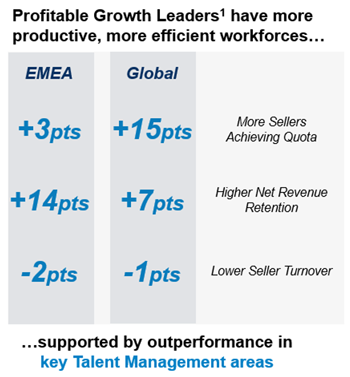Five Principles of Talent Management
How do leading organizations differentiate and outperform industry competitors?
Alexander Group’s latest research included 250+ commercial leaders across industries, including members of our EMEA women’s revenue leaders community, to gain their insights on the best practices for developing a talent management strategy that truly brings a competitive advantage. What can high-performance companies do to create a talent management strategy that offers exceptional results making them profitable growth leaders?
Profitable organizations’ top focus is on five things:
- Employee Experience
- Talent Acquisition
- Strategic Talent Architecture
- Sales Compensation and Total Rewards
- Coaching and Recognition
Combining these five components gives profitable growth leaders a more productive and efficient workforce, as shown below.

By incorporating an exceptional talent brand (employee experience, talent acquisition and strategic architecture) with commercial execution (compensation and coaching), profitable growth companies produce market-leading results in both EMEA markets as well as globally.
Employee Experience
As part of the research, participants at Alexander Group’s EMEA Women Revenue Leaders roundtables were asked about their views on the employee experience in 2023. They agreed that a company’s strong employee engagement correlates directly to increased customer satisfaction. Engaged employees are more likely to be productive, motivated and committed to achieving both their goals and the organization’s goals. Successful engagement efforts focus on workplace flexibility (flexible working hours, hybrid work and leave policies) and culture and cohesion (employee feedback, defined career paths and training programs).
As a result of these programs, profitable growth leader customer satisfaction was 9% higher for interactions with sales reps and 20% higher for service quality. Happy employees translate into better, higher-quality engagement with customers.
The participants also noted that while employees desire more workplace flexibility, they may not be able to achieve it, especially for manufacturing firms and other industries that require onsite work. In addition, corporate leaders are learning to balance the desire for more remote work and the need to make employees feel part of a team. One executive shared a best practice for a primarily remote workforce which was quarterly in-person team events. The meetings keep employees engaged as individuals and as a team, promoting the culture and cohesion talent component.
Talent Acquisition
Alexander Group’s research findings show that high-performance companies leverage existing top talent to fill open positions. Virtually 100% of profitable growth companies have well-documented programs like formal career pathing as they communicate career advancement opportunities to potential employees and recruit candidates with appropriate job skills.
The main sources used to fill primary seller positions are internal hires (35%), including promotions and cross-functional shifts, experienced hires from competitors (28%), experienced hires from other industries (15%), on-campus recruitment (15%) and recruits from customers (7%). In addition, a U.S.-based female executive commented that they are looking for experienced hires from other industries, noting transferable skills (such as non-profit development to tech sales) requiring out-of-the-box thinking to meet talent acquisition demands.
Many of the EMEA Women Revenue Leaders roundtable participants focus on combining internal hires who know existing company policies and systems, and incorporating competitive hires who can bring fresh ideas is another option to maximize talent. Graduate hires are still critical, but take longer to become productive sales reps.
Alexander Group findings indicate that it takes about three to four weeks to fill a role from job posting to offer, but it may take additional time for candidates to onboard. However, it may take even longer in some countries like Germany and France before sales reps are entirely in their role.
Strategic Talent Architecture
Profitable growth leaders focus on sales competencies that improve employee and customer experience. 100% of EMEA profitable growth companies measure employees’ skills and competencies and clearly define the skills required to execute a specific job. 80% of these leaders also use skills assessments to drive career advancement. By formally tracking employee skills and competencies at least quarterly, companies can:
- Map sales talent to the right roles and/or customer segments, resulting in a 3% higher Net Revenue Retention.
- Target specialized training to meet individual needs, drive transparent career progress, and retain and reward high-performing talent. 18% of companies with this training are more likely to use assessments to drive career progression effectively.
Skill measurement generally occurs during more frequent and informal coaching sessions as leaders meet with their sellers, versus at formal assessments. In fact, EMEA’s profitable growth companies are tracking employee skills on a more frequent, ongoing basis than other global companies.
Sales Compensation and Total Rewards
Competitive sales compensation plans are essential to attracting and retaining top talent. The #1 reason candidates accept offers is because of pay (70%), followed by company reputation (65%). However, the top reason that employees leave a company is also pay (45%), followed by the disapproval of management (45%) and lack of appreciation (45%). Compensation is critical to both attracting and retaining top talent.
For EMEA profitable growth companies, 75% are using source market data to inform pay levels, reviewing this data 15% more than the global average. In addition, 42% of these firms are more likely to identify pay as a top recruitment strategy, which is 16% higher than the global average.
Not only must sales compensation plans be well-designed and aligned to market practices, but they must also be well-communicated. For instance, 70% of profitable growth firms formally assess sales compensation plans for clarity to sellers, the same as the global average. However, there was not necessarily a significant difference in top-performing companies in terms of total target pay. Still, profitable growth companies had more sellers achieving their quotas, possibly hitting more sales accelerators.
Coaching and Recognition
Coaching and recognition programs help leading companies evaluate their success and drive results by improving employee performance. Companies are three times more likely to miss revenue targets when they fail to align goals with performance. Approximately 45% of EMEA profitable growth companies conduct formal performance meetings quarterly, while 40% conduct monthly performance meetings. These leading companies use a tighter span of control, having one less seller per manager. Finally, they are not afraid to push out poor-performing sellers, seeing an 8% higher involuntary turnover compared to their industry peers.
By using a formal cadence for performance and competency reviews, companies can track KPIs and metrics and compile a history of seller performance, making it easier to understand the appropriate role and fit for individuals and a more objective process.
Whether formal or informal, coaching is critical for skill development and progress. Coaching sessions serve not only to help employees in their current roles but also to keep on top of career advancement opportunities. A clear career path map is critical to communicate, recognize and promote team members, as well as supports long-term retention efforts.
Sales leaders can also share professional development opportunities during coaching sessions. The EMEA women revenue leaders noted that there is frequently a gap between “training” (which is often specific to the organization) and “professional development,” which is more desired but usually less available to up-and-coming team members. One leader noted that in the U.K., companies could take advantage of monies available through the Apprenticeship Levy, which provides funds for advanced education and degrees, benefiting both employees and employers. Professional development provides a positive return for both parties and can be used as a valuable part of talent acquisition programs and communicated through coaching sessions.
Join the Conversation
These five principles of effective talent management help EMEA companies reach revenue goals by creating programs that attract, retain and motivate employee performance. Alexander Group’s EMEA women revenue leaders’ community reflected on these findings while adding their own challenges and insights.

Learn More
Contact us to learn more about how to ensure your talent management strategies align with your growth objectives and that you are getting the most out of your talent investments.





